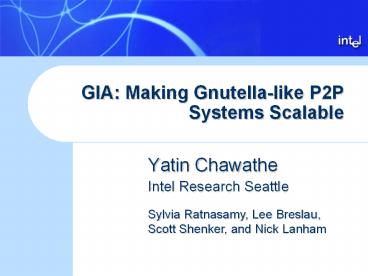GIA: Making Gnutellalike P2P Systems Scalable - PowerPoint PPT Presentation
Title:
GIA: Making Gnutellalike P2P Systems Scalable
Description:
GIA: Making Gnutella-like P2P Systems Scalable. Yatin Chawathe. Intel Research Seattle ... DHTs may be overkill. Incremental changes to deployed systems ... – PowerPoint PPT presentation
Number of Views:52
Avg rating:3.0/5.0
Title: GIA: Making Gnutellalike P2P Systems Scalable
1
GIA Making Gnutella-like P2P Systems Scalable
- Yatin Chawathe
- Intel Research Seattle
Sylvia Ratnasamy, Lee Breslau, Scott Shenker,
and Nick Lanham
2
The Peer-to-peer Phenomenon
- Internet-scale distributed system
- Distributed file-sharing applications
- E.g., Napster, Gnutella, KaZaA
- File sharing is the dominant P2P app
- Mass-market
- Mostly music, some video, software
3
The Problem
- Potentially millions of users
- Wide range of heterogeneity
- Large transient user population
- Existing search solutions cannot scale
- Flooding-based solutions limit capacity
- Distributed Hash Tables (DHTs) not necessarily
appropriate
4
Why Not DHTs
- Structured solution
- Given a filename, find its location
- Can DHTs do file sharing?
- Probably, but with lots of extra workCaching,
keyword searching - Do we need DHTs?
- Not necessarily Great at finding rare files, but
most queries are for popular files
5
Our Solution GIA
- Unstructured, but take node capacity into account
- High-capacity nodes have room for more queries
so, send most queries to them - Will work only if high-capacity nodes
- Have correspondingly more answers, and
- Are easily reachable from other nodes
6
GIA Design
- Make high-capacity nodes easily reachable
- Dynamic topology adaptation
- Make high-capacity nodes have more answers
- One-hop replication
- Search efficiently
- Biased random walks
- Prevent overloaded nodes
- Active flow control
- Make high-capacity nodes easily reachable
- Dynamic topology adaptation
- Make high-capacity nodes have more answers
- One-hop replication
- Search efficiently
- Biased random walks
- Prevent overloaded nodes
- Active flow control
Query
7
Dynamic Topology Adaptation
- Make high-capacity nodes have high degree (i.e.,
more neighbors) - Per-node level of satisfaction, S
- 0 ? no neighbors, 1 ? enough neighbors
- Function of
- Nodes capacity ? Neighbors capacities
- Neighbors degrees ? Their age
- When S ltlt 1, look for neighbors aggressively
8
Simulation Results
- Compare four systems
- FLOOD TTL-scoped, random topologies
- RWRT Random walks, random topologies
- SUPER Supernode-based search
- GIA search using GIA protocol suite
- Metric
- Collapse point aggregate throughput that the
system can sustain
9
Questions
- What is the relative performance of the four
algorithms? - Which of the GIA components matters the most?
- How does the system behave in the face of
transient nodes?
10
System Performance
11
Factor Analysis
12
Transient Behavior
Static SUPER
Static RWRT (1 repl)
13
Summary
- GIA scalable Gnutella
- 35 orders of magnitude improvement in system
capacity - Unstructured approach is good enough!
- DHTs may be overkill
- Incremental changes to deployed systems
- Status Prototype implementation deployed on
PlanetLab
14
Why Not DHTs
- Structured solution
- Given a filename, find its location
- Tightly controlled topology file placement
- Unsuitable for file-sharing
- Transient clients cause overhead
- Poorly suited for keyword searches
- Can find rare files, but that may not matter
15
GIA Design
- Make high-capacity nodes easily reachable
- Dynamic topology adaptation
- Make high-capacity nodes have more answers
- One-hop replication
- Search efficiently
- Biased random walks instead of flooding
- Prevent nodes from getting overloaded
- Active flow control
- Make high-capacity nodes easily reachable
- Dynamic topology adaptation
- Make high-capacity nodes have more answers
- One-hop replication
- Search efficiently
- Biased random walks instead of flooding
- Prevent nodes from getting overloaded
- Active flow control
16
GIA Design
- Make high-capacity nodes easily reachable
- Dynamic topology adaptation
- Make high-capacity nodes have more answers
- One-hop replication
- Search efficiently
- Biased random walks
- Prevent overloaded nodes
- Active flow control
- Make high-capacity nodes easily reachable
- Dynamic topology adaptation
- Make high-capacity nodes have more answers
- One-hop replication
- Search efficiently
- Biased random walks
- Prevent overloaded nodes
- Active flow control
17
Factor Analysis
TADAPT 0.001
TADAPT 0.2
RWRT 0.0005
OHR 0.005
BIAS 0.0015
GIA 7
OHR 0.004
BIAS 6
FLOWCTL 0.0006
FLOWCTL 2































